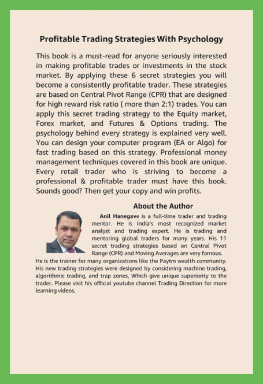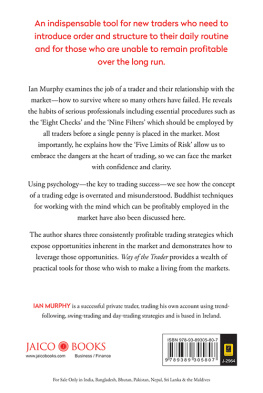price action
trading
secrets
Trading Strategies, Tools, and Techniques
to Help You Become a Consistently
Profitable Trader
rayner teo
Copyright 2020 by Rayner Teo.
All rights reserved. No part of this publication may be reproduced, distributed, or transmitted in any form or by any means, including photocopying, recording, or other electronic or mechanical methods, without the prior written permission of the publisher, except in the case of brief quotations embodied in critical reviews and certain other noncommercial uses permitted by copyright law. For permission requests, write to the publisher, addressed Attention: Permissions Coordinator, at the address below.
TradingwithRayner Pte Ltd.
www.tradingwithrayner.com
Printed in the United States of America.
Cover Designer: Rudi Design.
Layout Designer: Mala Letra Diseo Editorial / Sara F. Salomon.
Editor: Barry Lyons & Renata Sielecki, and Ng Wei Jun.
Chart Illustrations: www.tradingview.com and Jet Toyco.
disclaimer
The information contained in this book is for educational purposes only.
No representation is being made that any account will or is likely to achieve profits or losses similar to those discussed in this book. The past performance of any trading system or methodology is not necessarily indicative of future results.
By reading this book, you agree that my company and I are not responsible for the success or failure of your trading business.
The ideas Im about to present are ones that Ive learned from other traders (see the acknowledgements section) and I dont claim to be the original source of them.
table of content
introduction
When I was 20 years old, I read a book on investing called: Buffettology . It explained how the worlds richest investor, Warren Buffet, chose companies to invest in.
I was fascinated by how a man could become so wealthy simply by picking the right stocks to hold for the long run. Who wouldnt be?
After reading Buffettology , I was hooked. I began looking for anything I could find to make myself a great investor.
I read books on value investing and fundamental analysis. After a while, I noticed the authors kept repeating the same three elements:
- Ensure the company has more assets than liabilities.
- Ensure revenue, net income, and cash flow are increasing every year.
- Ensure the company has growth potential.
Et voil: The secret to successful investing!
Now, armed with my newfound knowledge, I was ready to pounce on any opportunities that appeared on the markets.
The first stock I bought was Sembcorp Marine in 2009 because it had solid fundamentals and the markets were recovering from the financial crisis.
I went long at $3.28 and told myself to hold this stock until the price doubled!
Five days later, I bailed out at $3.08. What a chicken I was.
Then, after some reflection, I realized my emotions had triggered this action. So, unwilling to give up just yet, and with the markets making a bull run, I knew I had to get back in the game.
Being naive and ambitious, I did more research and bought more companieswith margin.
Heres what I bought: I went long on Noble Group, Keppel Land, and Sembcorp Marine with an initial outlay of $20,000.
In two months, I was up close to $10,000. But being a fundamentalist who was trying to emulate Warren Buffet, I held on.
At this point, I felt like a champion with a knack for picking stocks. Even my broker commented that everything I touched turned to gold.
Two weeks later, my $10,000 in unrealized profits vaporized. The euro debt crisis had hit the markets.
Now I had nothing to show but my bitterness. Eventually, I bailed out of all my positions because I couldnt bear the pain of watching my profits turned into losses.
After my failed attempt at being an investor, I figured being a trader would be betterand thats when I started trading on the forex (foreign exchange) market.
Because I was new to forex trading, I looked to the Internet for help. I browsed forums, books, and whatever I could get my hands on.
My first taste of trading came when I was learning from a guru (on an online forum). He had a huge following and many traders worshipped him like a god.
I figured, they cant all be wrong, can they? So I learned from him too.
He taught us to use Bollinger Bands, to buy at the lows and sell at the highs. I traded this strategy for a while and made money at the start, only to lose it all later.
Then, I came across a quote that said something like this: Indicators are useless because they lag behind the markets. Focus on price instead.
This led me to the world of price action trading. I learned about support and resistance, trendlines, candlestick patterns, and many other things.
Again, I had a few winning trades at the start, but slowly, the losses came and eroded all my profits.
At this point, I wondered to myself, Maybe the strategies Im using are too simple. I need to find something more complex so the chances of it working will be higher.
This brought me to the world of harmonic patterns where I learned about stuff like the Gartley, the Crab, the Shark, the Cypher, etc. (Im not kidding. Those were the actual names of the patterns).
Again, the results were the same and the cycle repeated itself for four-plus years.
At that point, I was frustrated and confused. I asked myself, What the heck are the profitable traders doing that Im not?
After years of trial and error, I finally realized my mistake. It wasnt the strategies, the systems, or the chart patterns.
Rather, my mistakes were rooted in my lack of understanding of the natural laws of trading. I fought against these laws and paid the price. But when I finally embraced them, my trading changed forever.
Today, I manage a seven-figure portfolio, trade across forex, stocks, and ETFs, and have more than 100,000 traders following my TradingwithRayner blog each month. What a ride!
So you might be wondering, If youre so good, why write a book and give away all your secrets? Thats a great question. Heres why: There are no secrets when it comes to trading.
If youre talking about price action trading (or discretionary trading), then there are no secrets since most of the information can be found in books, courses, and online sources.
Also, price action trading is subjective. The way you interpret a chart will naturally be different from the way another trader sees it. For example, if you asked five traders to draw support and resistance lines, youd likely get five different answers. This means that even if something is a secret, the subjective nature of price action trading will affect the way people interpret that secret.
And this brings me to the question: If there are no secrets in price action trading, then why write a book about it? Well, there are three reasons. Heres the first one:
It will make me more money.
Heres the truth. Writing a book will make me more money and diversify my sources of income. Also, if you think my book is good, theres a good chance youll sign up for my premium training programs in the future (and that will make me even more money).
Heres the second reason:
It will inspire my children.
I want my children to know that they can achieve anything they set their minds to. If Papa can write a book, so can I. If Papa can be a trader, so can If Papa can do it, so can I!
And heres the third:
Ill be able to leave behind a legacy.
In the end, I want to leave something behind in this world. Call it a legacy, sheer ego, or whatever. I just want to be remembered even after Im gone. And to achieve this, I must write a damn good book so Ill be rememberedand I hope Price Action Trading Secrets is the kind of book that will be remembered.
Next page










